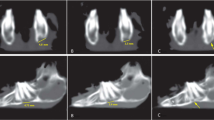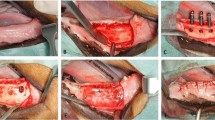Abstract
Ina retrospective study validated by a standardized clinical and radiologicalexamination, the bone regeneration in 90 patients with cystic mandibulardefectswas examined. In 50 patients bony defect reconstructions with humandemineralised bone matrix (HDBM) were carried out, while in a comparable groupof 40 patients the hollow pockets were left to regenerate bone spontaneously.The bone regeneration after the implantation of human demineralised bone matrix(HDBM) was subjected to a comparative validation. Osteoinductive proteinspresent in HDBM (bone morphogenetic proteins) can diffuse into the implant seatand induce new bone formation (osteoinduction). A markedly faster and morethorough bone regeneration was demonstrated after the surgical therapy ofcysticmandibular lesions with HDBM than without. HDBM also proved to be exceptionallybiocompatible.
Similar content being viewed by others
References
Cunningham N.S. and Reddi A.H. 1992. Biologic principles of bone induction: application of bone grafts. In: Habal M.B. and Reddi A.H. (eds), Bone grafts and bone substitutes. Saunders, Philadelphia, USA, pp. 93–98.
Delloye C. 1999. The use of Freeze-dried Mineralised and Demineralised Bone: Chapter 2 Bone Allografts. In: Phillips G.O., Strong D.M., von Versen R. and Nather A. (eds), Advances in Tissue Banking Vol. 3. World Scientific, Singapore, pp. 45–65.
Denner K., von Versen R., Freistedt B., Klein M. and Dehmlow R. 1989. Zur Relevanz laborchemischer Methoden zur Bewertung der Osteoinduktivitët von Knochenmatrix-implantaten. Z. med. Lab. diagn. 30: 159–164.
Gerhardt O. 1998. Keratozysten in der Mund-, Kiefer-und Gesich tschirurgie, thesis, Humboldt-Universitét zu Berlin.
Heubisch W. 1996. Rechtliche Zulcssigkeit der Anwendung von gefriergetrocknetem humanen Knochenmaterial. Bay. Zahnréztebl. 4: 53–54.
Kramer I.R.H., Pindborg J.J. and Shear M. 1992. Histological typing of odontogenic tumors. In: WHO International Histological Classification of Tumors. 2nd edn. Springer-Verlag, Berlin.
Kübler N.R., Steveling H., Reuther J., Bialas M. and Urist M.R. 1993. Auffullüng von Kieferzysten mit autolysiertem, allogenem Knochen (AAA-Bone). Dtsch. Z. Mund. Kiefer. GesichtsChir. 17: 95–97.
Kübler N.R. 1997. Osteoinduktion und-reparation. Mund. Kiefer. GesichtsChir. 1: 2–25.
Kübler N.R. 1998. Knochenregeneration durch Osteoinduktion. Dtsch. Zahnarztl. Z. 53: 834–843.
Nogami H. and Urist M.R. 1975. Transmembrane bone matrix gelatin induced differentiation of bone. Calcif. Tissue Res. 19: 153–163.
Reddi A.H. and Huggins C.B. 1972. Biochemical sequences in the transformation of normal fibroblasts in adolescent rats. Proc. Natl. Acad. Sci. USA. 69: 1601–1605.
Senn N. 1889. On the healing of aseptic bone cavities by implantation of antiseptic decalcified bone. Am. J. Med. Sci. 98: 219–243.
Singer R. and Ratajczak T. 1996. Zur Problematik von Knoch enersatzmaterialien in der zahnärztlichen/kieferchirurgischen¨ Praxis. Bay. Zahnärztebl. 7/8: 83–86.
Soost F., Stoll C., Gerhardt O. and Neumann H.J. 1999. Keratozysten der Kiefer mit Ausbreitung in die Schädelbasis. Zentralbl. Neurochir. 60: 11–14.
Soost F. 2000. Validierung des Knochenumbaus von Knochenersatzmaterialien in der Mund-, Kiefer-und Gesichtschirurgie Habilitationsschrift. Humboldt-Universität, Berlin.
Terheyden H., Jepsen S., Vogeler S., Tucker M. and Rueger D.C. 1997. Recombinant human osteogenic protein 1 in the rat mandibular augmentation model: differences in morphology of the newly formed bone are dependent on the type of carrier. Mund. Kiefer. GesichtsChir. 1: 272–275.
Thielicke U., Thielicke B., von Versen R. and Denner K. 1990. Klinische Studie zum Einsatz von demineralisierter Knochenmatrix (DBM) in der Chirurgischen Stomatologie. Beitr. Orthop. Traumatol. 37: 461–465.
Urist M.R. 1965. Bone Formation by autoinduction. Science 150: 893–899.
Urist M.R., Silverman B.F., Buring K., Dubuc F.L. and Rosenberg J.M. 1967. The bone induction principle. Clin. Orthop. 53: 243–283.
von Versen R., Denner K., Freistedt B., Sehrt B. and Matthes G. 1989. Verfahren zur Präparation demineralisierter Knochenmatrix. Z. med. Lab. diagn. 30: 154–158.
Wissenschäftlicher Beirat der Bundesarztekammer: Richtlinien and Nather A. (eds), Advances in Tissue Banking Vol. 3. World zum Führen einer Knochenbank. 93: 49–53.
Wolfinbarger J.L. 1999. Processing factors contributing to production of maximally osteoinductive demineralised ground bone for use in orthopaedic or periodontal applications: Chapter 2 Bone Allografts. In: Phillips G.O., Strong D.M., von Versen R. Scientific, Singapore, pp. 125–145.
Yim C.J. 1999. Biology of the demineralised bone and its clinical use: Chapter 2 Bone Allografts. In: Phillips G.O., Strong D.M., von Versen R. and Nather A. (eds), Advances in Tissue Banking Vol. 3. World Scientific, Singapore, pp. 87–111.
Author information
Authors and Affiliations
Rights and permissions
About this article
Cite this article
Kuhls, R., Werner-Rustner, M., Küchler, I. et al. Human demineralised bone matrix as a bone substitute for reconstruction of cystic defects of the lower jaw. Cell Tissue Banking 2, 143–153 (2001). https://doi.org/10.1023/A:1020173119669
Issue Date:
DOI: https://doi.org/10.1023/A:1020173119669




